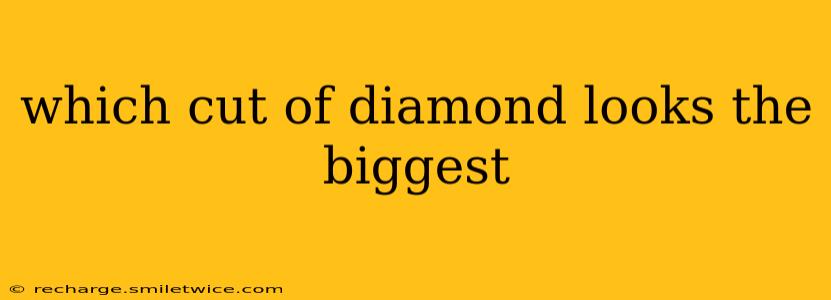Choosing a diamond is a significant investment, and understanding how different cuts affect a diamond's appearance is crucial. While carat weight indicates the diamond's physical size, the cut significantly impacts how large a diamond appears. The cut determines how well a diamond interacts with light, influencing its brilliance, fire, and scintillation—factors that contribute to its overall perceived size. So, which cut makes a diamond look biggest? Let's explore.
What Factors Make a Diamond Look Bigger?
Before diving into specific cuts, it's important to understand the elements that contribute to a diamond's perceived size. These factors work in conjunction with the cut:
- Brilliance: This refers to the white light reflected from a diamond's facets. A brilliant diamond appears brighter and, consequently, larger.
- Fire: This refers to the flashes of colored light (typically red, orange, yellow, and green) that are a result of light dispersion. More fire can make a diamond seem more substantial.
- Scintillation: This is the sparkle or "life" of a diamond—the twinkling effect created by the light's interaction with the facets. A diamond with excellent scintillation seems larger and more dynamic.
- Depth and Table: These proportions significantly impact light return. A well-proportioned diamond will maximize brilliance, fire, and scintillation, making it look larger than a poorly cut diamond of the same carat weight.
- Symmetry and Polish: While not directly impacting perceived size, excellent symmetry and polish ensure that light interacts with the facets optimally, contributing to brilliance and thus size perception.
Does the Round Brilliant Cut Make a Diamond Look Biggest?
The round brilliant cut is often cited as the cut that makes a diamond look the biggest. This is because its 57 or 58 facets are precisely arranged to maximize light return. When expertly cut, a round brilliant diamond exhibits exceptional brilliance, fire, and scintillation, contributing to its apparent size. However, a poorly cut round brilliant will appear smaller and duller.
What About Other Diamond Cuts?
While the round brilliant often wins in the "biggest-looking" category, other cuts can also create an illusion of larger size:
- Princess Cut: With its square or rectangular shape and brilliant facets, a princess cut diamond can appear larger than a similarly weighted diamond of other cuts, especially if it has excellent proportions.
- Emerald Cut: The step cuts of the emerald cut create a hall-of-mirrors effect, giving the diamond a more elongated and open look, which can also make it appear larger. However, this cut emphasizes clarity, so inclusions may be more visible.
- Oval Cut: The oval cut's elongated shape can create the illusion of length, which can contribute to its perceived size.
How Can I Choose a Diamond That Looks the Biggest for My Budget?
The best way to ensure you get a diamond that looks its largest for your budget is to prioritize cut grade. An excellent cut grade, regardless of the shape, will always maximize light return and make the diamond appear larger and more brilliant than a diamond with a lower cut grade. It's essential to examine the diamond's proportions, symmetry, and polish when evaluating its cut. A reputable jeweler can help you understand the grading reports and select a diamond with the best potential for maximizing its apparent size.
What is the difference between carat and cut?
Carat refers to the diamond's weight, while cut describes how well the diamond's facets interact with light. A 1-carat diamond with an excellent cut will look significantly larger than a 1-carat diamond with a poor cut.
Does the setting affect how big a diamond looks?
Yes, the setting can impact the perceived size. A setting that allows light to reach the diamond from all angles will enhance its brilliance and make it appear larger. Prongs that are too thick or a setting that obscures parts of the diamond can make it look smaller.
How can I tell if a diamond's cut is good?
Look for a diamond with an excellent or ideal cut grade from a reputable grading laboratory like GIA or AGS. These reports will detail the diamond's proportions, symmetry, and polish. A jeweler can also help you assess the cut quality visually.
By understanding these factors and focusing on cut grade, you can select a diamond that maximizes its apparent size and brilliance, ensuring you get the most impressive stone for your investment. Remember to consult with a trusted jeweler for personalized guidance.
